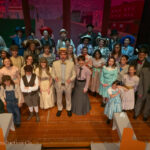Forget about the foxtrot— throw away the waltz! Take away the two-step and all that other schmaltz! Are you ready for what’s been going on in Phoenix? It’s a doozy…makes ya’ woozy…it’s the new phenomenon— well…not that new…but the first production of Mel Brooks’ Young Frankenstein this side of Charm City since 2022 (SLCT in Rising Sun!) And it’s all the rave and roar right in this reviewer’s backyard— Third Wall Productions and their zany, madcap production of Young Frankenstein. Arguably the most ambitious theatrical undertaking the company has done on this side of the pandemic, possibly even since their 2018 production of Jekyll & Hyde, this production pulls out all the technical stops (with a few technical gremlins, goblins, hiccups, and hitches on opening night) and brings a vocally talented, exuberant and enthusiastic cast onto the stage for some singing, dancing, and— well, tomfoolery at its finest! Woof! Directed by Mike Zellhofer, with Musical Direction by Eliyahu Kheel, Choreography by Beth Dixon, and Orchestra Pit conducted by Lynn Graham, it’s an electrifying musical theatre experience for sure.
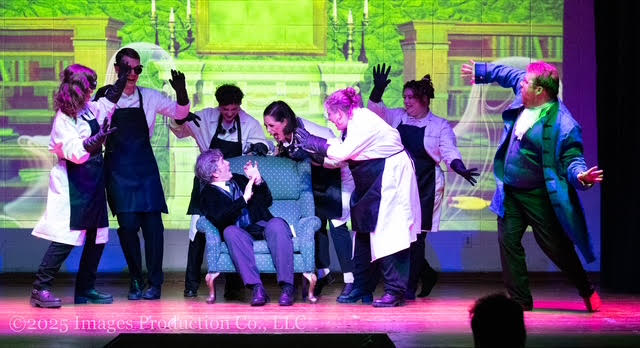
One of the wildest and arguably most successful components of the production comes from mastermind Bob Berkebile, responsible for the projection design, which swallows not just the scrim on the back wall of the stage, but the whole of either side of the auditorium so you have a rather immersive experience. (Berkebile also has rubber chickens hidden in the set-projections…I gave up after counting at least four…) You get a full-on Transylvanian village, the inside of the Frankenstein castle, and a rumpy-pumpy-rolly-polly hayride that not only exist impressively on these walls— but they move. “Roll in the Hay” almost becomes a 4D-Disney-ride experience because of this nifty effect! And when Victor Frankenstein (Joshua Torrence, who boldly belts his way through “Join the Family Business”, showcases some eye-high-Rockette-style fling kicks, and concludes the number with a superb series of dance-twirls) has to appear himself in ghostly form, the portrait (actual members of the cast are used to fill in the portrait frames) dissolves in green acid and the actor— POOF— right there on stage. And there’s ghostly projections to accompany “Join the Family Business” as well. Berkebile has a phenomenally immersive series of projections that really elevate the theatrical engagement experience for this production!
Praises are owed to Lighting Designer Jim Shomo for keeping the light-work simple and effective. There’s one incredibly appropriate use of swinging swirl lights— the hot white spot-searches that flash about as “Puttin’ On The Ritz” concludes and breaks down into chaos. Shomo also has a few blinking colors featured when Frederick and the team are attempting to bring the creature to life as well but for the most part it’s static, effective color lighting that helps augment the astonishing projections that Bob Berkebile has designed, enhancing the experience rather than detracting from it. It’s truly remarkable how fully a show can shine in the right lighting, especially when the lighting tactics remain simple; Shomo’s work here is arguably some of his best.
The two big issues with the production were the overall sound balance (and some major microphone issues with mics not being switched off so that backstage discussions can be heard and mics not being switched on when characters are first entering scenes) in relation to the play space and the house as a whole. While the orchestra finally seems masked enough to not overplay the performers, the mics were so hot that for large portions of the production, their result was nearly deafening. This is especially true when the ensemble is devolving into shrieking and screaming chaos (when the villagers are running rampant during bits before, during, and after “He’s Loose” and its various callbacks.) Many of the singers are so powerful that they’re over-blasting their mics. This is a sound-check issue, which hopefully Sound Designer Charles Hirsch and those running the sound-op board, can address as the production goes forward; the space is more intimate than it seems and the sound on the mics can be lowered, providing that the orchestra stays as dialed back as they currently are.
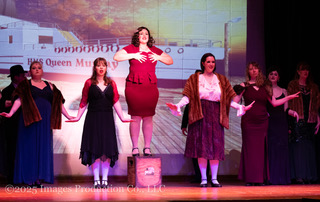
The show’s other major issue is the scene changes. Director Mike Zellhofer has some pretty heavy drag spots all throughout the production, which gum up the pacing and the natural flow of the show. This is an issue both in clearing ‘full-stage scenes’ from a cast perspective as often the more crowded numbers are having stragglers not clearing the visible stage space quick enough and in a scenery sense, which is somewhat disconcerting as the physical pieces of scenery are minimal (allowing the projection to really shine and set the scene.) Zellhofer could utilize the front-curtain more, to help mask scene changes, which do not need to wait until a number or scene is fully concluded to begin. The perfect example of this would be having the Eliabeth Bennett character step in front of the curtain as The Monster wanders off from their cave scene, closing the curtain behind her, and allowing her to perform her “Deep Love (Reprise/Call Back)” in front of the closed curtain so that the setup for back and the lab can be completed behind the curtain by the time her number is finished, rather than waiting for her to complete the song before beginning that transition. With the projections that extend out into house, we fully recognize that she’s still in the cave, even though you can no longer see the back wall of the stage. There are numerous transitions throughout the production where this type of technique could have been employed, which would have exponentially helped the pacing of the show.
Zellhofer does, however, bring a lively bunch of performers together and not without some cheeky, ‘true-to-Third-Wall’ style Easter Eggs. Someone harps a bit on ’05 (which even if it is scripted that way, the way that it’s delivered becomes a callback to their previous production of The Music Man, where Harold Hill was class of ’05.) You get a lyrical shift in the show’s finale to promote their upcoming fall production of Hairspray and there are quite a few other nods sprinkled throughout the performance (along with the rubber chickens) that will make fans of the theatre company chuckle.
The aforementioned set pieces, which do intentionally remain simple, are quite carefully and cleverly crafted. Pat Rudai and Marc Graff build a coffin, a very unique and perfect for their play-space ‘wagon’ (which ran zero people over at this performance) for “Roll in the Hay” and they have benches and chairs and a rolling gurney that give you that ‘mad scientist feel.’ Shoutout to Properties Master Anastasia Graff for that wild-looking light-up transference device! The overall aesthetic of the show’s set pieces and props are both clean and in-line with everything that’s happening on the projection side of the production; it’s a unifying blend to present a visually appealing show!
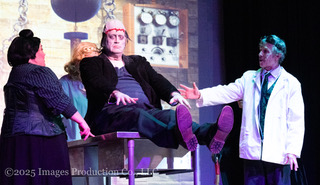
Costumes (by way of Caitlin Johnson and Amy Rudai) augment the visual experience of the show— in particular that fabulous wardrobe setup on Masha, Sasha, Tasha, Basha, and Bob (played by Sam Brady, Beth Dixon, Krystyna Graff, Rita Mallouh, and Kim Vogel…not necessarily in that order) all wearing fabulous shades of polka dot couture in black and white with red accents, to show how they serve as perfect accoutrements to Elizabeth Benning, the Doctor’s madcap fiancé! Johnson and Rudai get the villagers looking festive as well, many lively colors for their dreary village, and a bakery-brown lederhosen for Ziggy, the Village Idiot. The series of fashionably fabulous red outfits featured on Elizabeth Benning are also glorious, as is the starkly contrasting dark greens seen on Frau Blucher **HORSE WHINY** and the whole Herr Drosselmeyer-inspired togs seen on Inspector Kemp.
The show’s choreography certainly had its moments, when Beth Dixon keeps the dancing groups smaller— like the eight featured tappers on stage during the dance break for “Puttin’ on the Ritz” it works well, and using featured dancers during “Transylvania Mania” (Joe Weinhoffer and Gray Jabaji doing tumble flips there and Gage Wright and Andi Rudai doing a hot-n-fast Charleston-inspired move up on the stage later in the number) showcases both the choreographic skillset that Dixon possesses and what some of her dancers can do. At other times, mostly when trying to mobilize the ensemble of a dozen and a half plus some of the featured performers, the limited stage space— even with Dixon putting people on the outer aisles of the house and down in front of the stage’s apron— creates some confusion and some static in the dance routines. The spatial awareness of the audience-to-stage ratio seems to be a problem on the whole for this production (both from a how loud they are standpoint and ‘where they are’ standpoint.) While its excellent that Zellhofer and Dixon want to keep the stage itself from being overcrowded and attempt to create that engaging immersive experience by bringing performers out into the house, the spatial blocking and awareness needs some tightening. During “He’s Loose (Reprise)” it’s great that the villagers are turning the house asunder hunting for the monster— but they’re clashing into one another down that very narrow center aisle, almost tumbling into audience members. It’s a good effort and a great effect when achieved successfully, it just needs a little bit of finessing.
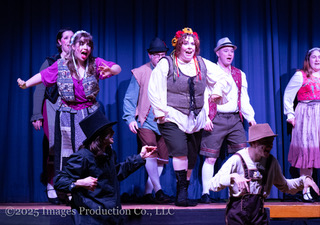
We’re putting in a petition to change orchestra conductor Lynn Graham’s name to St. Cecelia, the patron saint of musicians everywhere. Graham’s masterful skillset as a conductor was in full service at the opening night performance. There were quite a few musical hiccups— actors starting too soon, not soon enough, falling a little off their tempo, getting a little ahead of their tempo— but unless you’ve seen the show a good dozen times you wouldn’t catch 95% of these missteps because of how swiftly Graham brought her orchestra to heel and had them covered. (Again this comes back to the microphones being overly loud; it stands to reason that the performers were having trouble hearing the orchestra and even with the assistance of the overheard monitor, it can create an issue; the pit does not need to play louder, the mics just need to come down.) Graham and her orchestra (Featuring: Kevin Jones on bass, Eric Allard & Rachel Daudelin on violin, Stephanie Taylor & Jamie Sawers on woodwinds, Larry Engel & Wes Freeman on trumpet, Harry Swartz on trombone, Stephen Kaltreider on horn, Winfield Clasing on drums, Billy Georg on percussion, and William Zellhofer on keys) were beautifully balanced, created some lovely music, and kept the show running as smoothly as was possible from a musical-pit standpoint.
From a vocal standpoint, Musical Director Eliyahu Kheel has done a very impressive job with the 18 ensemble members, particularly when it comes to blending them together. Tonal balance is prevalent in Kheel’s approach to this cast, as is encouraging their high-spirited energies. You get roars of enthusiasm from “The Happiest Town in Town” and a lot of terror infusing their sounds when they flip the script and sing “He’s Loose” in its various iterations. The ensemble (featuring: Sam Brady, Alex Clasing, Beth Dixon, Krystyna Graff, Mea Holloway, Gray Jabaji, Caitlin Johnston, James Leftkowitz, Dan Luber, Rita Mallouh, Jssica Preactor, Andi Rudai, Brittney Smith, Hope Standish-Pallanck, Kim Vogel, Jay Weiner, Joe Weinhoffer, Gage Wright) delivers hearty and robust sounds all throughout the performance. And you get an extra special treat from four talented fellas— Joe Weinhoffer, Jay Weiner, Joshua Torrence, and James Lefkowitz— for “Welcome to Transylvania.” Dulcet, well-blended barbershop quartet style harmonies marry these four voices together sublimely for that often-dismissed-as-a-throwaway-number. And you won’t be able to miss Lefkowitz as the ‘town crier’ at the top of “The Happiest Town” when he leads the coffin-carrying procession through the house’s central aisle, belting out ‘make way.’ Weinhoffer also gets a hilarious cameo as a certain unnamed…creature of the night…at the very end of the show, swooping in and earning himself a serious of thunderous giggles. Watch him closely, you might even catch that character trying to flirt with Elizabeth Benning; it’s fang-tastic!
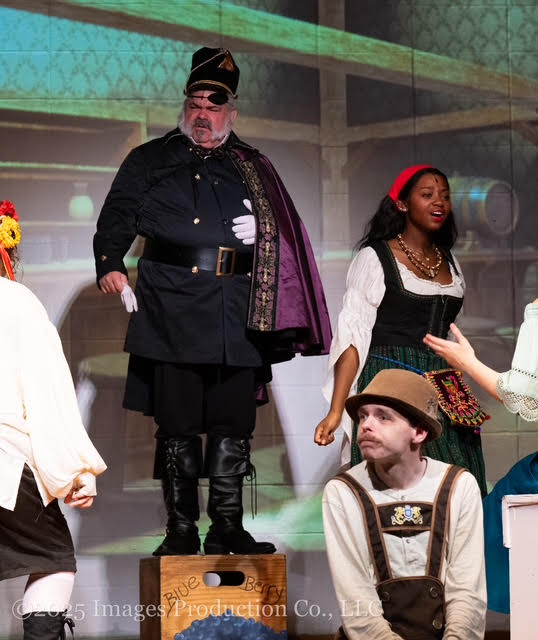
Cory Bauer, as Ziggy…the Village Idiot…is mostly seen and not heard but his explosive body language, his hilariously over-the-top facial expressions and his general mindfulness of how to play the fool are perfect for the role. Often seen tailing Inspector Kemp (B. Thomas Rinaldi), Bauer’s Ziggy is the perfect comedic attaché to Rinaldi’s kooky character. With an accent thick like frozen molasses, Rinaldi’s Inspector Kemp plays right into the gimmicky nature of the character and his vocals for “The Law” “He’s Loose” and other moments where the character gets caught up in song are perfect for the part. The same can be said for Jim Morgan, playing The Hermit, who only appears for one number in the second act and for a quick callback at the end of the show. Morgan’s performance of “Someone” is both humorous and delightful on the ear. His shuffling around in the scene with the monster inside his quaint cottage is also smartly timed and executed.
With multiplying beauty marks that seem to be second cousins to gremlins after midnight, Kristen Cooley’s Frau Blucher **HORSE WHINY** is a scene-stealing supporting character that audiences just can’t get enough of! With a crisp and dour accent, the severity that Cooley brings to Blucher **HALF WHINY** is spot-on with the character’s film-origins. But there’s a uniqueness to Cooley’s performance as well— the groan-worthy puns as she prepares the stage for “Puttin’ on the Ritz” and her general approach to delivering dialogue and comedic timing are just sublime. And when Cooley takes to belt-blasting her way through “He Vas My Boyfriend” the audience is so torn between thunderous laughter and whooping applause that you might even consider Frau Blucher **HORSE WHINY** to be a show-stopper.
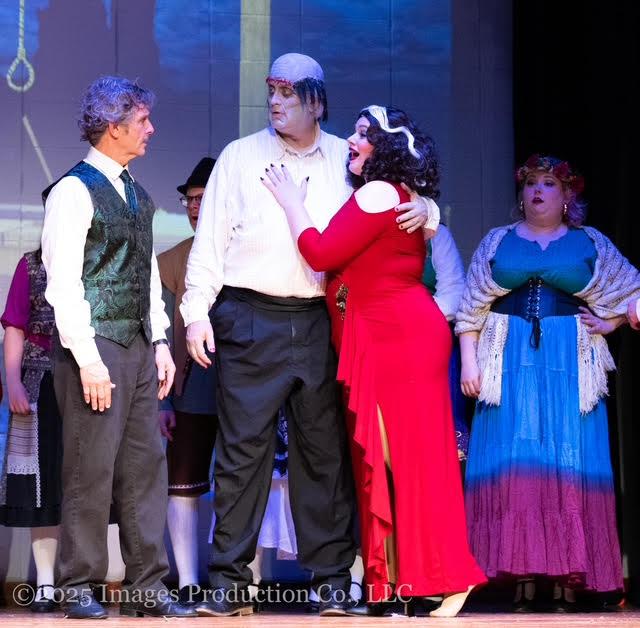
Grunts. Grumbles. Groans. Oh my! Nick Ruth masters The Monster with ease when it comes to stalking about the stage in that stiff-limbed-just-reanimated-from-the-dead fashion that only a true creature-creation could successfully achieve. Staying in character the entire time, even with the cheekier interactions shared between his character and the Elizabeth Benning character, you get the sense that Ruth really knows the show’s source material. And when he finally does gain the power of speech and song, it’s articulate, well-toned, and clear. His dance moves are pretty on point as well, keep a close eye on his feet during “Puttin’ on the Ritz” and the trembling back-screen projections during that number.
It’s her! It’s her, it’s her, it’s her! It’s— her, her, her, her! Her, her, her, her…HER. Jillian Paige. Wearing the princess track of Elizabeth Benning with glam, glory, and a whole lot of gusto, Paige’s scene-stealing, show-stopping antics are giving Megan Mullally vibes with a hint of local freshness. Paige can belt. No question. “Deep Love” can likely be heard all the way back at the cemetery of this reviewer’s house (3.8 miles drive back down into Glen Arm) and her infectious, indefatigable smile bursts from her face and flows through her body language whether she’s sassing Freddy in “Please Don’t Touch Me!” or scolding him post “Surprise.” Paige has an undeniable vivacity about her, making her the perfect pick for the Eliabeth Benning role in this production. Sashaying her way in and out of scenes, even though she only has three numbers, you won’t be able to take your eyes or ears off of her and the way she exudes confidence is enviable!
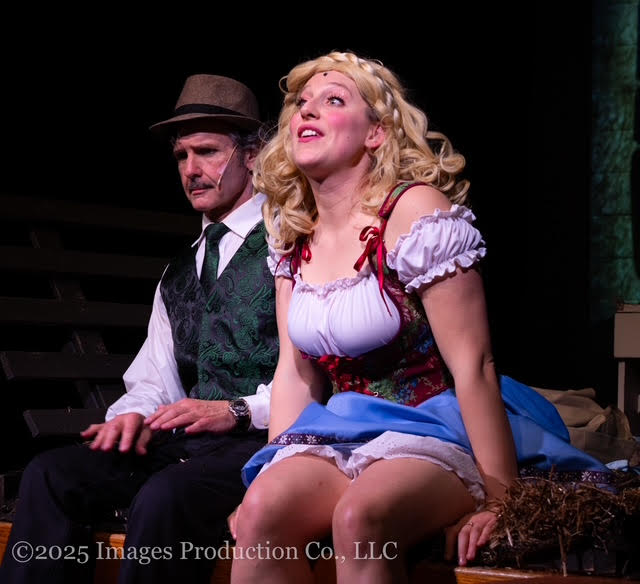
Playing a slightly more coquettish lady character, though no less talented, Sylvia Kowalski is taking Inga in a Ulla vein, as it were. (And let’s face it, all Mel Brooks’ musicals are essentially interchangeable so it’s not that far of a stretch.) Kowalski is not afraid to flaunt her vocal prowess, her intense dance moves, or her characters intentions all over the place. With what is arguably the most consistent overly-exaggerated accent in the production, she’s razzling and dazzling her way through numbers like “Roll in the Hay” and “Listen To Your Heart.” Her boundless enthusiasm knows no bounds and her bubbly, effervescent persona is just exploding in every scene. Vocally she’s got a good handle on her middle-register belts and this is quite useful for “Roll in the Hay.” She also has a clean head-transitional voice to slide into some of those higher notes with ease during “Listen To Your Heart.” And the meet-cute chemistry that she shares with Frederick Frankenstein is just adorable.
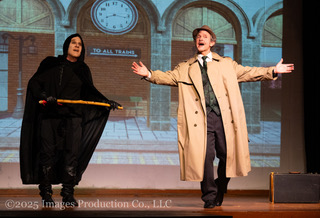
Like Max B. and Leo, like tax evasion and Rio, like Chandler and Geller— it’s Mitch Fishbein and Neil Beller— together again for the first time! Tackling the roles of Igor and Frederick Frankenstein respectively, the pair have an odd chemistry that suits the show just fine. Fishbein, as the hump-having, laboratory assistant has his moment in the spotlight when he sneakily steals the wrinkly brain, flubs it, and then recovers a smooth, abnormal one instead. And when he snarl-bites at Elizabeth, that’s one of the funniest moments in the show. He matches Beller’s energy for their various duets and songs together and makes for a good body in motion in this production. Beller has wildly animated facial expressions, not unlike Gene Wilder and Rogert Bart. And his generalized cluelessness to some of the show’s scenarios as they unfold on his character are hilarious— like when Inga starts falling all over him during “Roll in the Hay.” With a patter that could give Harold Hill a run for his money, Beller nails that ‘scientists cram-roll’ at the tail-end of “The Brain” and his vocal sustains are impressive. You get this clear tone, strongly asserted, all throughout the performance when it comes to Beller finishing whatever song he’s singing and it imbues the audience with a sense of appreciation for what he’s doing to make the character work. His “Soliloquy” is arguably one of the most emotionally impressive moments that he belts out. Beller even has an ad-lib here or there, mostly under-breath-muttered but if you catch them, they’re hysterical.
So jump on your wagon and roll yourself down to Third Wall Productions to see some truly talented performers, some out of this world theatrical projections, and have yourself a good evening of live, local theatre.
Running Time: 2 hours and 40 minutes with one intermission
Young Frankenstein plays through April 13th 2025 with Third Wall Productions, in residence at Chestnut Grove Presbyterian Church— 3701 Sweet Air Road in Phoenix, MD. Tickets are available by at the door or in advance online.
Ohhhhh forget about the foxtrot! Throw away the waltz!
Take away the two step, and all that other smaltz
Arrre you ready for, what’s been going on?
Iiiiit’s a doozy
Makes ya’ woozy
It’s the new phenomenon!



